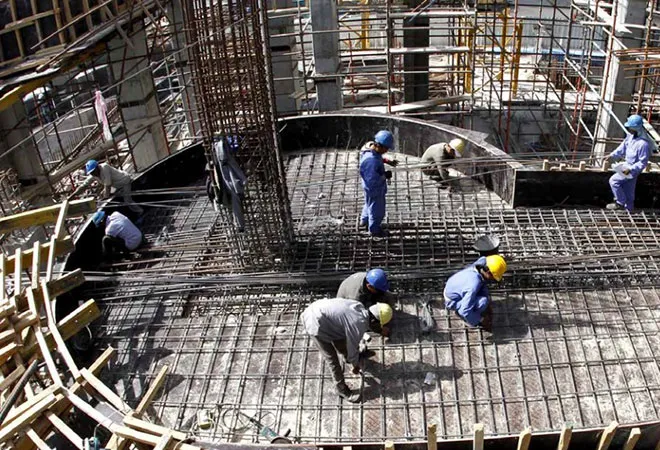
International labour migration from Nepal to India has been a historically acknowledged fact, accredited to the presence of similar ethno-linguistic patterns and low cost of movement across the open border. Therefore, necessitating the importance of crossborder understanding for increased collaboration in the present trying time of widespread COVID pandemic. This piece explains the efforts of the Nepali and Indian governments for migrant labourers. With this, the aim lies at creating a more congenial environment for the stranded people across border, reeling under the pressure of survival without basic facilities.
In the absence of stringent restrictions and even the requirement of proper clearance, thousands of Nepalese from the rural far-western or mid-western regions of the small landlocked Himalayan country have been flocking into India for economic opportunities. Given the country’s LDC status, 85 per cent of the population living on subsistence farming, often ends up choosing vocation-based jobs in Indian metropolises. Likewise, they are able to turn their backs towards caste and gender discrimination — along with unemployment and the prevailing lacuna in tapping natural resources of their own country.
Given the country’s LDC status, 85 per cent of the population living on subsistence farming, often ends up choosing vocation-based jobs in Indian metropolises.
Consequently, the remittances generated have also increased three-fold in the past two decades, leveling up the expectations of the Nepali economy. In 2017, Nepal had been ranked fifth-highest in the ratio of remittances to GDP (28. 3 per cent) in the world. This means that the money sent in by Nepalese citizens working abroad forms almost one-third of the GDP.
With the ongoing novel coronavirus crisis that has hit the world, plight of these migrant labourers stuck in foreign countries like India is considered to be more of a curse, than a boon. Advertently, this questions the interest of these labourers to travel abroad in the future, devoid of the basic guarantee of survival during a crisis situation, thereby indirectly threatening Nepal’s most crucial source of income. Although this is the unorganised/informal sector of the host countries where these workers are being engaged, inadequacies can incur huge costs because of the sizeable population being affected.
The inadequate system
Since the beginning of this global pandemic, the Raxaul–Birgunj border between India and Nepal, the largest Indo-Nepal gate (in general, there are around 37 motor-able land entry points with India and all of it have been closed) has been witnessing several thousands of stranded workers, especially from Bihar and Uttar Pradesh, desperate to go back to their homeland. In fact, the no man’s land between the two countries saw people from either side waiting for more than 30 hours to get access to other side of the border. However, amidst the ongoing lockdown and the relevant guidelines of social distancing issued by the World Health Organisation (WHO) and the respective governments, security forces forced such people to relocate themselves in the nearby quarantine centres before the situation aggravated further.
No man’s land between the two countries saw people from either side waiting for more than 30 hours to get access to the other side of the border.
A similar picture could also be drawn on the Nepali side as well, where the Sashastra Seema Bal (SSB) restricted several Indian nationals working in various parts of Nepal to walk across the Indo-Nepal Friendship Bridge. People who tried to cross over by swimming across the Mahakali river in the Darchula district were also arrested by the Nepali police.
Nonetheless, the mass exodus of around 540 Nepali migrant labourers from India to Nepal escaping from quarantine centres, has a different story to tell about the inadequacies faced by them, predominantly working as the major push factor for such migrants to leave. Similarly, around 400 Indian migrant labourers are also placed in the quarantine centres of Birgunj, without any certainty of going back to their homeland. Lack of food, absence of basic hygiene wherein there was one soap for around 30 people at large, no facility of portable drinking water and lack of sanitation were a few major reasons why the centres could not amass popularity in this scenario. Many people chose to spend the night in the nearby fields rather than such centres and only came back in day time to avail the food being distributed.
Adding up to this, the expensive tea being sold outside the centres, some price at Rs 10 have also been mentioned as most people do not have that much money to access the daily necessities of life. There are around 25 to 30 people being lodged into single rooms of places like school buildings, (around 276 buildings in Bihar have been converted into quarantine centres) where survival has become a challenge in itself and the concept of social distancing is a big illusion.
Under the circumstances, it is also a threat to the idea of maintaining social distancing as people who might be asymptomatic could be the unknown carriers, infecting several others in these centres. Complaints of various levels were witnessed. These ranged from mosquitoes to caste/class discrimination and xenophobic attacks in the quarantine centres, which apparently are not being noted or addressed by the local governments of the particular areas.
There are around 25 to 30 people being lodged into single rooms of places like school buildings, where survival has become a challenge in itself and the concept of social distancing is a big illusion.
Again, since the health desks at the borders lack proper infrastructure — with only a simple thermometer to check the temperature of the returnees, many people have been successful in escaping before the declaration of the lockdown. This has made the situation even worse as most of these people are moving on to different rural areas, where hospitals capable of treating corona affected patients are also scarce.
What can be done?
After much hue and cry, the Supreme Court in Kathmandu recently issued an interim order for repatriation of the Nepali nationals who are stuck in the foreign countries and living under deteriorating conditions. The apex court pointed out that the health and safety of the citizens was the primary concern of the country. There was also much pressure from the human rights commissions along with many critics arguing how this ‘exile like’ measure on part of the government was against the Constitution of 2015 in Nepal.
Foreign Minister Pradeep Kumar Gywali also owned up to this situation, mentioning pressure from organizations like the Non-Resident Nepalis Association (NRNA), representing the Nepali community in more than 11 countries across the globe. Though there have been strict orders from the court to take immediate action, the government is not being able to take any concrete decision fearing the furtherance of the entry of the virus in the country and breaching the lockdown.
The countries have urged the diplomatic missions to deal with the situation, which are supposedly falling into deaf ears, as argued by most of the people who are suffering. Many have also compared this situation to the highly vulnerable HIV/AIDS which had spread like wildfire in the northwestern provinces of Nepal during the 1990s mainly from the migrant labourers coming back from India, thereby exposing their communities. Naturally Nepal wants to avoid the spread of any such deadly virus within its territory — mainly the rural areas where hospital facilities are not adequate and people still have to travel to Kathmandu for any specialised treatment.
Though there have been strict orders from the court to take immediate action, the government is not being able to take any concrete decision, fearing the furtherance of the entry of the virus in the country and breaching the lockdown.
In a case where there is panic and prevailing misinformation all around, what could have been of solace is a strong crossborder healthcare facility in existence. In the absence of such a facility, it is obvious that the governments of both India and Nepal can only rely on reassurances of the governments without measures taken on ground. Video conferences have not been enough to change the harsh circumstances that are still prevailing while we are moving towards the end of the second phase of the lockdown, which again might be increased due to the growing number of cases.
As a neglected area, healthcare has now demanded its due credit which would definitely take a longer period to get reestablished in its full glory. However, with failing remittances and the doom of uncertainty that hovers around economic prosperity, a much higher price will have to be paid in the near future. This will not only decrease the revenue of the government but also the liquidity in the banking industry.
In order to escalate this situation for the better, bigger steps have to be taken like ensuring more than just Rs 500 million for the COVID-19 fund. It is well accepted that sending the migrants home is not a viable option. Hence, facilities like the availability of doctors along with other basic necessities that have been shown on paper must be provided in reality as well along with sufficient media coverage of the entire scenario. It is only then that the true essence of the lockdown would be justified. Otherwise, the constant turmoil among the people would worsen the situation and bring in harm for the entire region.
The views expressed above belong to the author(s). ORF research and analyses now available on Telegram! Click here to access our curated content — blogs, longforms and interviews.




 PREV
PREV



